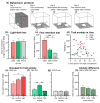Observational Fear Learning in Rats: Role of Trait Anxiety and Ultrasonic Vocalization
- PMID: 33810488
- PMCID: PMC8066558
- DOI: 10.3390/brainsci11040423
Observational Fear Learning in Rats: Role of Trait Anxiety and Ultrasonic Vocalization
Abstract
Rats can acquire fear by observing conspecifics that express fear in the presence of conditioned fear stimuli. This process is called observational fear learning and is based on the social transmission of the demonstrator rat's emotion and the induction of an empathy-like or anxiety state in the observer. The aim of the present study was to investigate the role of trait anxiety and ultrasonic vocalization in observational fear learning. Two experiments with male Wistar rats were performed. In the first experiment, trait anxiety was assessed in a light-dark box test before the rats were submitted to the observational fear learning procedure. In the second experiment, ultrasonic vocalization was recorded throughout the whole observational fear learning procedure, and 22 kHz and 50 kHz calls were analyzed. The results of our study show that trait anxiety differently affects direct fear learning and observational fear learning. Direct fear learning was more pronounced with higher trait anxiety, while observational fear learning was the best with a medium-level of trait anxiety. There were no indications in the present study that ultrasonic vocalization, especially emission of 22 kHz calls, but also 50 kHz calls, are critical for observational fear learning.
Keywords: anxiety; observational fear learning; rat; ultrasonic vocalization.
Conflict of interest statement
The authors declare no conflict of interest.
Figures





Similar articles
-
Rat ultrasonic vocalization in aversively motivated situations and the role of individual differences in anxiety-related behavior.Behav Brain Res. 2006 Jan 30;166(2):271-80. doi: 10.1016/j.bbr.2005.08.009. Epub 2005 Oct 4. Behav Brain Res. 2006. PMID: 16213033
-
Overt behavior and ultrasonic vocalization in a fear conditioning paradigm: a dose-response study in the rat.Neurobiol Learn Mem. 2005 Nov;84(3):228-40. doi: 10.1016/j.nlm.2005.07.004. Epub 2005 Aug 22. Neurobiol Learn Mem. 2005. PMID: 16115784
-
Relaying Aversive Ultrasonic Alarm Calls Depends on Previous Experience. Empathy, Social Buffering, or Panic?Brain Sci. 2021 Jun 8;11(6):759. doi: 10.3390/brainsci11060759. Brain Sci. 2021. PMID: 34201037 Free PMC article.
-
Stress-induced vocalisation in adult animals. A valid model of anxiety?Eur J Pharmacol. 2003 Feb 28;463(1-3):133-43. doi: 10.1016/s0014-2999(03)01277-9. Eur J Pharmacol. 2003. PMID: 12600706 Review.
-
Ethotransmission: communication of emotional states through ultrasonic vocalization in rats.Curr Opin Neurobiol. 2013 Jun;23(3):310-7. doi: 10.1016/j.conb.2013.01.014. Epub 2013 Jan 31. Curr Opin Neurobiol. 2013. PMID: 23375168 Review.
Cited by
-
Understanding Others' Distress Through Past Experiences: The Role of Memory Engram Cells in Observational Fear.Adv Neurobiol. 2024;38:215-234. doi: 10.1007/978-3-031-62983-9_12. Adv Neurobiol. 2024. PMID: 39008018 Review.
-
Stress-Induced Ultrasonic Vocalization in Laboratory Rats and Mice: A Scoping Review.Brain Sci. 2024 Oct 31;14(11):1109. doi: 10.3390/brainsci14111109. Brain Sci. 2024. PMID: 39595872 Free PMC article.
-
Exploring rodent prosociality: A conceptual framework.Transl Neurosci. 2025 Jun 11;16(1):20250375. doi: 10.1515/tnsci-2025-0375. eCollection 2025 Jan 1. Transl Neurosci. 2025. PMID: 40519842 Free PMC article. Review.
-
Biological Functions of Rat Ultrasonic Vocalizations, Arousal Mechanisms, and Call Initiation.Brain Sci. 2021 May 9;11(5):605. doi: 10.3390/brainsci11050605. Brain Sci. 2021. PMID: 34065107 Free PMC article. Review.
-
Social Behavior and Ultrasonic Vocalizations in a Genetic Rat Model Haploinsufficient for the Cross-Disorder Risk Gene Cacna1c.Brain Sci. 2021 May 29;11(6):724. doi: 10.3390/brainsci11060724. Brain Sci. 2021. PMID: 34072335 Free PMC article. Review.
References
-
- Blanchard R.J., Blanchard D.C. An ethoexperimental analysis of defense, fear, and anxiety. In: McNaughton N., Andrews G., editors. Anxiety. University of Otago Press; Dunedin, New Zealand: 1990. pp. 124–133.
LinkOut - more resources
Full Text Sources
Other Literature Sources

